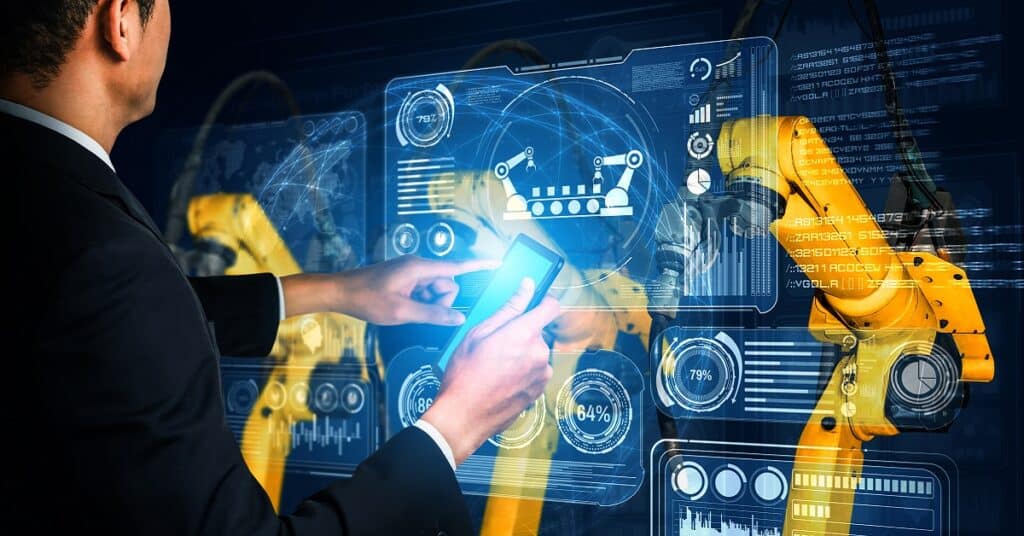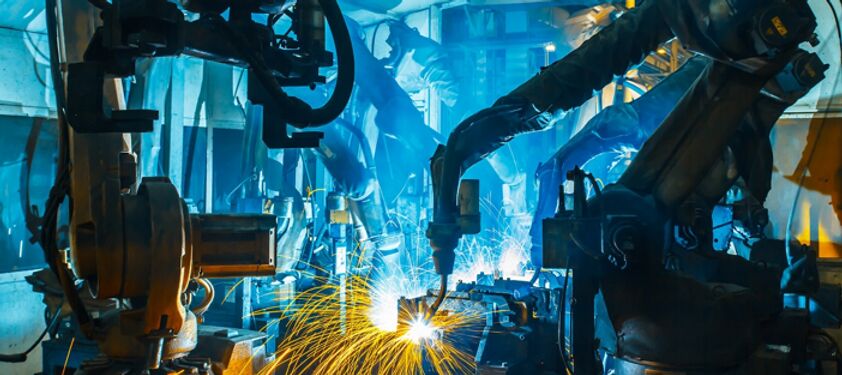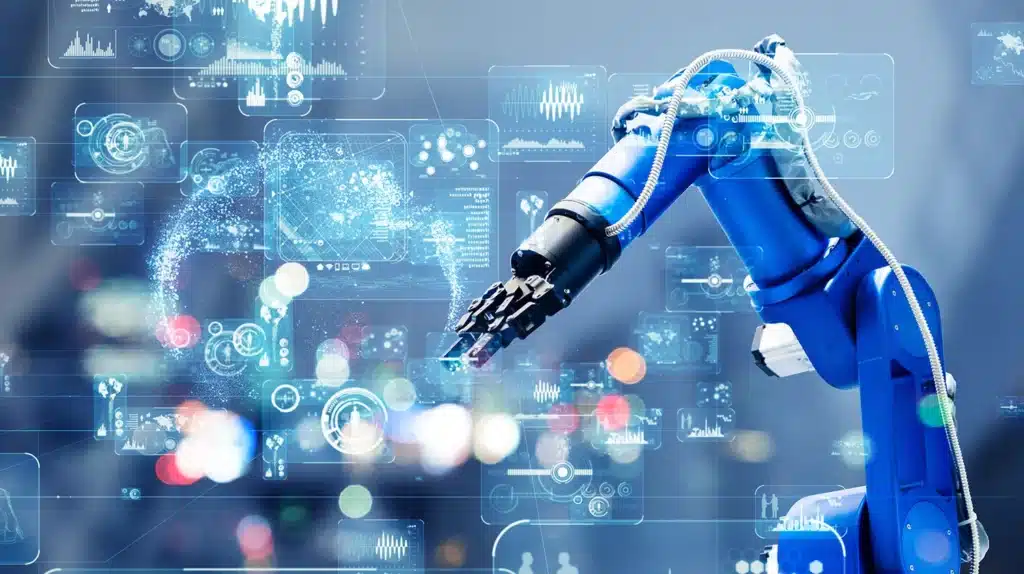(Strategies) Robotics, once relegated to science fiction, has become a palpable reality in a variety of sectors. From manufacturing to healthcare, the presence of robots is on the rise, raising questions about the future of automation and human-machine interaction. In this in-depth analysis, we will explore the increasing frequency of robotics, focusing on the importance of specialized expertise, the implementation of customized strategies, and the benefits related to time and resource savings.
In today’s dynamic landscape, augmented reality emerges as an innovative technology that is transforming the way we interact with the digital and physical environment. From entertainment applications to practical solutions in business, augmented reality opens up a range of fascinating possibilities. This comprehensive analysis will dive into the fundamentals of augmented reality, exploring its practical applications, impact on user experience, and the ethical implications that accompany this technological evolution. Along the way, we will examine how augmented reality is redefining the perception of reality and generating new forms of interaction in the digital age.
The Evolution of Robotics:
Analyzing the historical development of robotics.
The influence of artificial intelligence in the evolution of robots.
Current trends indicating an increase in the adoption of robots.
Space Exploration: Addressing the limits of human knowledge, space exploration has been a fascinating field that has evolved over the decades. From the first satellites to manned missions to the Moon, space technology has undergone significant transformation.
In this historical review, we will examine the key milestones that have marked the evolution of space exploration, highlighting the convergence of technology and engineering that has enabled the expansion of our understanding of the universe. In addition, we will explore how artificial intelligence has been incorporated into modern space missions, improving efficiency and decision making in extraterrestrial environments. This analysis will also address current trends in space exploration, including renewed interest in missions to Mars and growing international collaboration on space projects.
- Specialized Expertise in Robot Design and Programming:
The crucial role of robotics experts in design and development.
The importance of continuous training in a constantly evolving field.
Examples of flagship projects highlighting specialized expertise.
Innovations in Medicine: Specialized expertise in robot design and programming has found revolutionary applications in the medical field. Highly trained professionals in medical robotics are leading significant advances, from robot-assisted surgery to the delivery of precise, personalized treatments.
These experts not only design cutting-edge surgical robots, but also program complex algorithms that enable robots to perform medical procedures with unparalleled precision. Continuing education is essential in this field, as rapidly evolving technology and medical needs require professionals to stay abreast of the latest innovations.
Flagship examples include robotic systems used in minimally invasive surgery and nanorobotic devices that can perform specific tasks at the cellular level. Specialized expertise in robotics has not only improved efficiency in medical care, but has also opened up new possibilities for more precise and less invasive treatments.
- Current Applications of Robotics:
Exploring how robotics has been integrated into various industries.
Case studies that illustrate the positive impact of robots on operational efficiency.
Recent developments that have expanded the applications of robotics.
Automation in the Manufacturing Industry: Today’s applications of robotics extend to a variety of industries, and one prominent area is manufacturing. In industrial settings, precisely programmed robots perform repetitive and hazardous tasks, improving operational efficiency and reducing risk to workers. Case studies in the manufacturing industry reveal how robots have optimized production by speeding up manufacturing, minimizing errors and ensuring consistent quality. In addition, recent developments in collaborative robotics, where humans and robots work closely together, have expanded the applications of robotics in manufacturing, enabling greater flexibility in production and adaptability to changes in market demand. These advances demonstrate the positive impact of robotics in optimizing key industrial processes.
- Customized Strategies for Robot Implementation:
The need for strategies tailored to the specific needs of each industry.
Cases where customization has led to better robot integration.
Challenges associated with the implementation of customized strategies.
- Collaborative Robotics: Human-Machine Interaction:
Analyzing the growing importance of human-robot collaboration.
Strategies to achieve harmonious and efficient interaction.
Benefits and challenges of collaborative robotics in the work environment.
- Saving Time and Resources with Robotic Automation:
Evaluating how robots contribute to time savings in repetitive tasks.
Reducing operating costs by implementing robots.
Case studies quantifying resource savings with robotics.
- Relevant Keywords in Robotics:
Identification of crucial keywords for visibility and relevance in online searches.
Examples of keywords: “advanced robotics”, “industrial automation”, “collaborative robots”.
SEO strategies to stand out in the context of robotics.
- Robotics in Industry 4.0:
How robotics fits into the Industry 4.0 paradigm.
The contribution of robots to the digital transformation in manufacturing.
Successful cases that exemplify the convergence of technologies in industry.
- Ethical and Social Challenges of Robotics:
Addressing ethical issues related to robot autonomy.
Social impact of robotic automation on employment.
Strategies to mitigate ethical and social challenges associated with robotics.
- Robotics in Medicine and Healthcare:
- Current and future applications of robots in health care.
- The contribution of robotics to assisted surgery and rehabilitation.
- Benefits and challenges in the implementation of robots in healthcare settings.
- Future Perspectives of Robotics:
- Projections of how robotics will evolve in the coming decades.
- Technological innovations that could transform robotics.
- The role of artificial intelligence in the future of robotics.
- Robotics and Environmental Sustainability:
- Exploring how robotics can contribute to more sustainable practices.
- Robot applications in waste management, renewable energy and sustainable agriculture.
- Case studies highlighting the positive impact of robotics on the environment.
- Safety in Robotics:
- Addressing concerns about robot security.
- Strategies to prevent vulnerabilities and cyber attacks.
- The importance of standards and regulations in robotic security.
- Robotics Education and Training:
- The crucial role of education in preparing robotics professionals.
- Strategies to foster interest in STEM (science, technology, engineering and mathematics) and robotics.
- Successful educational initiatives that have boosted robotics knowledge.
- Economic Impact of Robotics:
- Assessment of how robotics impacts the global economy.
- Employment generation and economic opportunities associated with the robotics industry.
- Case studies demonstrating the economic contribution of robotics in different sectors.
- Intersectoral Collaboration in Research and Development:
- The importance of collaboration between companies, academic institutions and governments in robotics research.
- Joint research projects that have driven significant advances.
- Benefits of cross-sector collaboration to accelerate innovation in robotics.
- Robotics in Space Exploration:
- Robot contributions to space exploration and cosmic research.
- Development of robots designed for extraterrestrial environments.
- Flagship space projects that have taken advantage of robotics.
- Robotics in Agriculture:
- Robot applications in the modernization of agriculture.
- Drones and agricultural robots that improve efficiency and productivity.
- Impact on food security and agricultural sustainability.
Robotics and Accessibility:
- Robotic technologies designed to improve accessibility for people with disabilities.
- Robotic prostheses and exoskeletons that restore mobility.
- Challenges and opportunities in creating accessible technologies.
- Ethics in the Creation of Robots:
- Ethical considerations in the programming and use of robots.
- Ethical principles to guide the development and deployment of robots.
- Reflection on the social and ethical impact of robotics on society.
- Robotics and Art:
- Exploring the intersection between robotics and artistic expression.
- Robot-driven art projects.
- The influence of robotics on creativity and artistic innovation.
- Recent Developments in Artificial Intelligence for Robotics:
- Advances in algorithms and deep learning models applied to robots.
- Integration of AI to improve robot autonomy and decision making.
- Examples of cases where AI has taken robotics to new heights.
Robotics and Entertainment:
- Robot applications in the entertainment industry.
- Robotics in film and television production.
- Robot-driven interactive entertainment experiences.
- Development of Robotic Ecosystems:
- The creation of collaborative ecosystems between different types of robots.
- Integration of robots of different functions to achieve synergies.
- Examples of robotic ecosystems that have revolutionized industries.
- Robotics as an Educational Tool:
- The implementation of robots in educational environments to promote STEM learning.
- Pedagogical benefits of robotics in the formation of technical and creative skills.
- Educational initiatives that have successfully integrated robotics into curricula.
Navigating Towards a More Sophisticated Robotics Era: In the conclusion, we will reflect on the upward trajectory of robotics and its impact on society and industry. From the specialized expertise that drives innovation to the strategies that are driving it.
In closing this analysis, it is essential to reflect on the holistic impact of robotics and consider how these innovative technologies are shaping the future. From the specialized expertise that drives innovation to the implementation of customized strategies and savings in time and resources, robotics has proven to be a catalyst for change in a variety of industries.
Specialized training emerges as a key pillar in unlocking the full potential of robotics. Well-trained experts not only lead the design and development of advanced robots, but also act as drivers of creativity and tailored solutions. Continuing education and nurturing specialized skills are essential investments to successfully navigate the evolving robotic world.
Customized strategies, tailored to the specific needs of each industry, stand as an effective response to changing challenges. Flexibility and adaptability are critical in an environment where demands vary significantly. Cross-industry collaboration is presented as a vehicle for sharing knowledge and accelerating innovation, consolidating the role of robotics as a unifying force in society.
Safety, both in technical and ethical terms, is presented as a central consideration. Implementing robust security measures not only protects work environments, but also fosters confidence in the adoption of robotic technologies. Ethics, guided by principles that prioritize social welfare, becomes a beacon that lights the way to a more equitable and sustainable future.
Time and resource savings, driven by robotic automation, translate into operational efficiency and economic advantages. However, these savings go beyond financial efficiency, extending to the conservation of natural resources and reduction of the environmental footprint. Robotics, when applied with environmental awareness, can contribute to more sustainable practices and mitigation of negative impacts.
On the future horizon, robotics is not only envisioned as a technological tool, but as an agent of social, economic and cultural transformation. The intersection of robotics with education, art, space exploration and accessibility underscores its ability to go beyond task automation and enrich diverse aspects of human life.
As we navigate toward a more sophisticated robotic era, creativity and innovation continue to be essential drivers. The exploration of new robotic ecosystems, the development of emerging technologies, and the careful consideration of ethical and social implications are critical steps toward a future where robotics is harmoniously integrated into society and everyday life.
In short, robotics is not simply a tool, but an evolutionary companion that will shape the future landscape. With an experience-centric vision, adaptive strategies and the constant pursuit of improvement, we can confidently navigate toward a future where robotics plays a central role in improving the quality of life and building a more advanced and sustainable world.
Tips for Successfully Navigating the World of Robotics:
Invest in Specialized Training: Robotics technology is complex and rapidly evolving. Invest in specialized training for your teams to ensure they are up-to-date with the latest trends and techniques in robot design, programming and maintenance.
Tailor Strategies to Specific Needs: Each industry has unique requirements and challenges. Develop customized strategies that align with the specific needs of your industry. Flexibility and adaptability are key to the successful implementation of robotic technologies.
Focus on Human-Machine Collaboration: Collaborative robotics, where humans and robots work together, is a growing trend. Design systems that enhance collaboration and harmonious interaction between humans and robots to take full advantage of the capabilities of both.
Prioritize Safety: Safety must be a priority in the implementation of robots, especially when interacting with humans. Implement robust safety measures and follow standards and regulations to minimize risks and ensure safe working environments.
Consider Ethical and Social Aspects: Robotics raises ethical and social issues. Consider the impact of your developments on society, addressing employment, privacy and equity questions. Develop ethical robots and support socially responsible practices.
Explore Cross-Sector Collaborations: Innovation often comes from collaboration. Seeks opportunities to collaborate with other companies, academic institutions and governments to drive joint research and development in robotics.
Integrate Emerging Technologies: Stay abreast of emerging technologies, such as artificial intelligence and machine learning, and look for ways to integrate them into your robotic systems. These technologies can improve the autonomy and adaptability of robots.
Encourage Continuous Innovation: Innovation is key in the robotics world. Foster a culture of continuous innovation within your organization. Encourage your team to come up with new ideas and experiment with creative solutions.
Educate and Communicate: Education and communication are essential, both internally and externally. Educate your employees about robotics and clearly communicate the benefits of your robotic solutions to customers and stakeholders. Transparency builds trust.
Monitor and Constantly Improve: Establish monitoring systems to evaluate the performance of your robots. Analyze data and get feedback to identify areas for improvement. Continuous improvement is essential to maintain efficiency and competitiveness.
Evaluate the Economic and Social Impact: Understand and evaluate the economic and social impact of your robotic implementations. Consider how your actions can contribute to employment, local economy and sustainability.
Encourage Creativity in Robotics Application: Creativity can open up new opportunities. Encourage your team to think creatively in the application of robotics. Sometimes innovative solutions arise from unconventional approaches.
Key Robotics Caveats and Considerations:
Labor Displacement: Robotic automation can lead to worker displacement in certain industries. It is crucial to anticipate these changes and develop job retraining programs to mitigate the negative impact on employment.
Security and Privacy: As robots are integrated into everyday environments, security and privacy must be a priority. Robotic systems must be designed with robust measures to protect against potential threats and ensure data privacy.
Social Inequalities: Unequal adoption of robotics can contribute to economic and social inequalities. It is essential to address these issues through inclusive policies that ensure that all sectors of society benefit from robotic advances.
Technology Dependency: Excessive dependence on robotic technology can generate vulnerabilities. It is important to diversify strategies and not rely exclusively on robotics to avoid potential disruptions.
Ethics and Autonomous Decisions: Autonomous robotic systems pose ethical dilemmas, especially in situations where they must make critical decisions. Establishing clear ethical principles and regulations is essential to ensure ethical behavior in robotics.
Costs and Accessibility: The implementation of robotic technologies can be associated with significant costs. Ensuring affordability and avoiding the creation of technology gaps are important considerations for equitable adoption.
Cultural and Social Sensitivity: The introduction of robots into social and cultural environments must be approached with sensitivity. Understanding and respecting cultural differences is essential to avoid misunderstandings and resistance.
Environmental Sustainability: Despite their benefits, the manufacture and deployment of robots can have environmental impacts. It is critical to adopt sustainable practices at all stages of the robot life cycle to minimize their ecological footprint.
Continuous Upgrading: The rapid evolution of robotic technology requires continuous upgrading. Companies and professionals must commit to constant training to keep up with the latest trends and developments.
Resilience and Contingencies: Reliance on robotics also implies the need for contingency plans. Developing resiliency strategies to cope with potential technical failures or disruptions is essential to maintain stability.
Additional Considerations for Responsible Robotics Implementation:
Human-Robot Interaction: Effective human-robot interaction requires careful design. Considering aspects such as natural communication, empathy and emotional understanding is crucial to facilitate harmonious collaboration.
Transparency in Decision Making: Autonomous robotic systems must be transparent in their decision-making processes. Understanding how a robot reaches certain conclusions is essential to build trust and acceptance in its adoption.
Social Impact Assessment: Prior to widespread implementation, conducting social impact assessments is essential. Understanding how robotics will affect local communities and society as a whole will allow potential challenges to be addressed before they arise.






